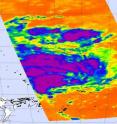Tropical Storm Tomas calls for alerts in south Pacific
System 97P was looking pretty impressive on NASA satellite imagery early today, March 11, and by 10 a.m. ET, it strengthened into Tropical Storm Tomas. Forecasters at the Fiji Meteorological Service (FMS) have posted a tropical cyclone alert for the South Pacific islands of Wallis and Futuna on March 11 at 05:53 UTC (12:53 a.m. ET). The FMS has also designated the storm as "Tropical Depression 14F."
The Territory of the Wallis and Futuna Islands is a Polynesian French island territory in the South Pacific between Fiji and Samoa. It consists of three main volcanic tropical islands and several islets.
At 1500 UTC (10 a.m. ET) Tropical Storm Tomas was located near 11.0 South latitude and 175.5 West longitude about 340 miles northwest of Pago Pago. It was moving west near 8 mph (7 knots). Tomas' maximum sustained winds were estimated near 39 mph (35 knots) and it was generating waves up to 11 feet high.
Tomas appears to continue strengthening, as bands of thunderstorms continue to wrap around the storm's low level center. NASA's Aqua infrared satellite imagery from the Atmospheric Infrared Sounder (AIRS) instrument confirm some deep convection (rapidly rising air that creates the thunderstorms that power tropical cyclones). The infrared image of Tomas captured on March 11 at 0105 UTC (Mar. 10 at 8:05 p.m. ET) showed some high, cold thunderstorms around the center of this large storm.
As the storm continues to intensify and move southwest, residents of the Wallis and Futuna Islands should pay close attention to their local forecasts. It is expected to become a cyclone in the next day or two.
Source: NASA/Goddard Space Flight Center
Articles on the same topic
- GOES-12 captures south Atlantic Tropical Storm 90Q far from Argentina's coastFri, 12 Mar 2010, 21:30:23 UTC
- NASA's Aqua Satellite shows strong convection in Tropical Storm UluiFri, 12 Mar 2010, 21:30:22 UTC
- Tropical Storm Tomas approaching Nadi this weekendFri, 12 Mar 2010, 21:09:05 UTC
- Second only south Atlantic tropical storm: 90Q, moving away from BrazilThu, 11 Mar 2010, 21:45:53 UTC
Other sources
- GOES-12 captures south Atlantic Tropical Storm 90Q far from Argentina's coastfrom PhysorgFri, 12 Mar 2010, 22:56:21 UTC
- GOES-12 captures south Atlantic Tropical Storm 90Q far from Argentina's coastfrom Science BlogFri, 12 Mar 2010, 22:22:06 UTC
- Tropical Storm Tomas approaching Nadi this weekendfrom Science BlogFri, 12 Mar 2010, 22:21:57 UTC
- Tropical Storm Tomas approaching Nadi this weekendfrom PhysorgFri, 12 Mar 2010, 22:14:37 UTC
- NASA's Aqua Satellite shows strong convection in Tropical Storm Uluifrom PhysorgFri, 12 Mar 2010, 21:49:32 UTC
- Second only south Atlantic tropical storm: 90Q, moving away from Brazilfrom PhysorgFri, 12 Mar 2010, 0:42:36 UTC
- Tropical Storm Tomas calls for alerts in south Pacificfrom PhysorgThu, 11 Mar 2010, 23:35:20 UTC
- Tropical Storm Tomas calls for alerts in south Pacificfrom Science BlogThu, 11 Mar 2010, 23:21:16 UTC
- Second Tropical Cyclone Ever Forms in South Atlanticfrom Live ScienceThu, 11 Mar 2010, 23:14:06 UTC
- Second only south Atlantic tropical storm: 90Q, moving away from Brazilfrom Science BlogThu, 11 Mar 2010, 22:14:13 UTC
- 90Q: A curious short-lived 'tropical' cyclone in the southern Atlanticfrom PhysorgWed, 10 Mar 2010, 22:35:55 UTC
- 90Q: A curious short-lived 'tropical' cyclone in the southern Atlanticfrom Science BlogWed, 10 Mar 2010, 21:35:23 UTC
